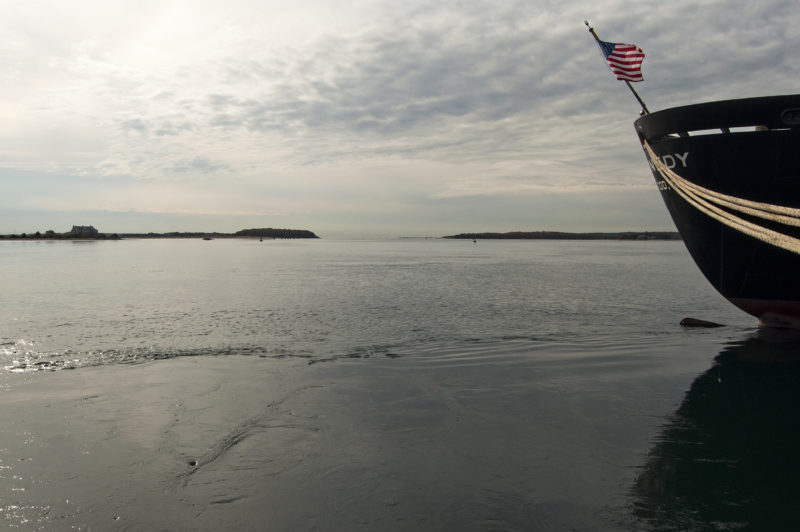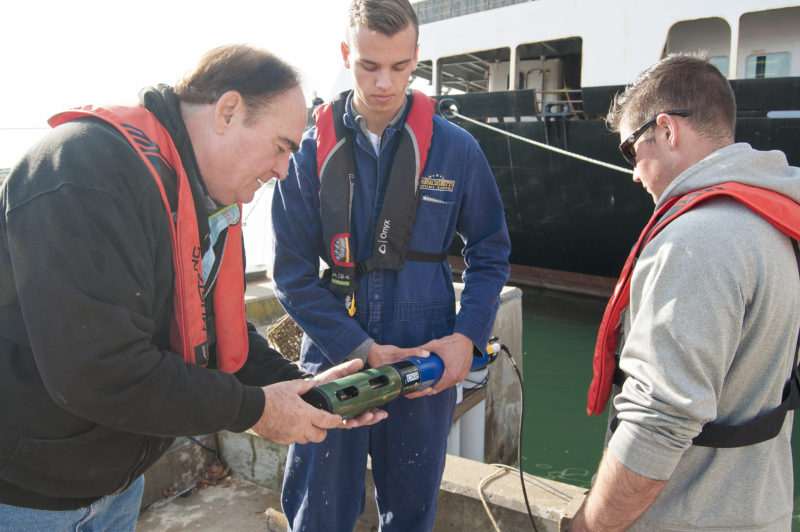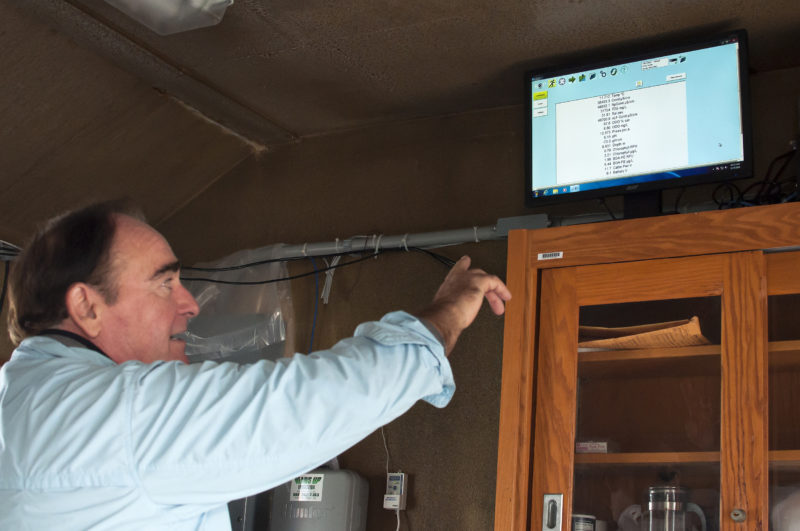At Massachusetts Maritime Academy, students using technology to collect strong science in upper Buzzards Bay
Sitting along the edge of the Cape Cod Canal at the head of Buzzards Bay in Bourne, the Massachusetts Maritime Academy is a world-class destination for college students studying maritime and environmental protection. Now, students at the academy are helping the Coalition collect sound science through an innovative collaboration that aims to protect clean water in the upper Bay.

Swift currents flow in and out of the Cape Cod Canal next to Massachusetts Maritime Academy at the head of Buzzards Bay.
The Buzzards Bay Coalition and the Massachusetts Maritime Academy aren’t strangers – the Coalition’s original office was located in the Third Company dormitory on the academy’s Taylor Point campus nearly 30 years ago. But this past spring, the Coalition and the academy came together as new partners in scientific research.
Through a first-of-its-kind collaboration funded by a grant from the EPA’s Southeast New England Program, the Coalition has partnered with the academy and the towns of Wareham, Bourne, and Plymouth to reduce nitrogen pollution from wastewater to the upper Bay. Specifically, the project is studying the feasibility of moving the Wareham wastewater treatment plant discharge pipe from the Agawam River – a small, sensitive waterway suffering from too much nitrogen pollution – to the open waters of Buzzards Bay by the Massachusetts Maritime Academy.
It’s a big idea – one that needs a strong foundation in sound science to succeed. And the Massachusetts Maritime Academy is just the place to collect this data.

Massachusetts Maritime Academy professor Bill Hubbard helps students Tyler Aldrich and Connor Ives inspect the sonde, which records data about water conditions every 15 minutes.
Swift currents flow in and out of the Cape Cod Canal next to the academy’s aquaculture laboratory, where Professor Bill Hubbard oversees students enrolled in the Marine Safety & Environmental Protection program. “I call it the students’ lab – they can study anything they want,” Hubbard said, surrounded by tanks filled with oysters, clams, and a colorful array of fish. These student-led projects range from research on marine invertebrates to an extensive mapping of Buzzards Bay’s bottom habitat.
The academy’s partnership with the Coalition has created a new project for these students studying careers in marine biology and environmental research. For the next two years, Professor Hubbard’s students will monitor environmental conditions in the upper Bay to collect baseline data about the health of the water that flows past the laboratory.
The students are collecting this data using a device called a sonde, which sits within a blue PVC tube deep in the water just off the pier’s concrete ledge. The sonde hangs from the end of a rope attached to a special stand created by academy staff. Every 15 minutes, the sonde logs data on key factors of the water’s health, including temperature, algae, salinity, oxygen, and pH. “The accuracy of the data obtained is quite amazing,” said Hubbard, who often strings an underwater camera down with the sonde to record the fish and shellfish that thrive below the surface.
The project is a formal independent study for seniors Tyler Aldrich and Connor Ives, who are learning about marine resource management under Professor Hubbard. “Both of us were immediately interested in the independent study,” said Ives, who hopes to join the Coast Guard as a marine technician after graduation. “Monitoring the water quality of Buzzards Bay ties into every core class we have taken in our major.”
Aldrich and Ives are responsible for keeping the sonde clean and in working order. Once a month, the students also collect water samples on the incoming and outgoing tide. They filter those water samples in the aquaculture laboratory, and then send the samples to the Marine Biological Laboratory in Woods Hole to be analyzed for algae and nutrients.
Watching the currents rush rapidly past the edge of the Massachusetts Maritime Academy pier, it’s obvious how much water moves through the upper portion of Buzzards Bay in and out of the canal. By recording data every 15 minutes 24 hours a day, the sonde is providing a steady stream of information about how the upper Bay’s water quality changes with the tides.

Professor Bill Hubbard points out a computer in the aquaculture lab displaying real-time data streaming from a sonde that sits deep in the water off the pier at Massachusetts Maritime Academy.
This monitoring will continue for as much of the year as possible – another feature of the project that makes the data so valuable. The Coalition’s Baywatchers program focuses on the summer months, when the harmful effects of nitrogen pollution are worst. The data from Massachusetts Maritime Academy will show how water quality changes throughout the fall, winter, and spring.
And the data isn’t just useful for the Coalition project, according to Hubbard. It’s proving to be valuable for a broad range of research in Buzzards Bay, including his bottom habitat mapping project. The academy’s diving team has also gotten into the habit of stopping by the lab to check out water temperatures before they suit up.
For Aldrich, whose goal is to become a diver with the NOAA Corps, the study is providing real-world experience that will someday reach far beyond the waters of Buzzards Bay. “One of the major principles of diving within the Corps is being able to apply new technologies to perform efficient underwater operations,” he explained. “This water quality study has given me an understanding of how newer technologies can benefit the integrity of the nation’s waters.”